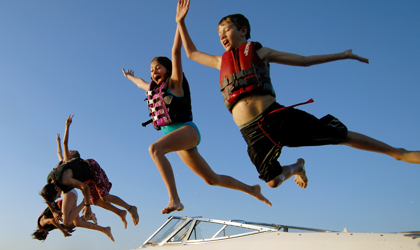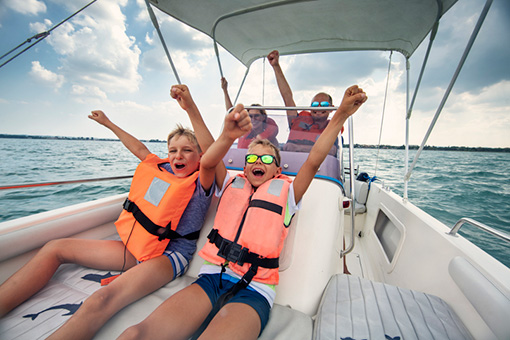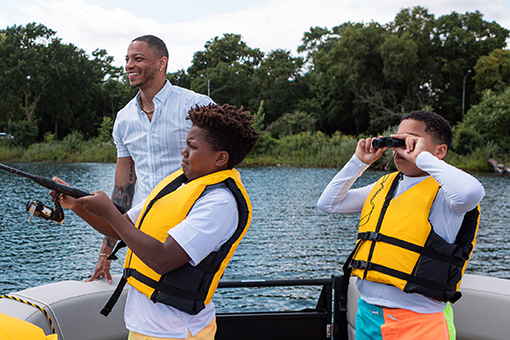They say if your child hasn’t been bitten by the bug to fish or boat by the time he is 13, he likely never will take up either sport. And if his first fishing and boating experiences are defined by confined boredom and a constant need to be quiet, still and patient, he’ll likely lose interest even before that tender age. Kids stink at all of these, and introducing them to boating and fishing in way that gives them the right taste of the game is infinitely more important in the formative years.
Few kids can turn down a fishing trip unless they’ve been on a disastrously boring one. Coop them up and bury them under “don’ts” and “must nots” and leave out the snacks and drinks and fishing goes from tantalizing to torture. To do it correctly, a parent needs to be part buddy, part adventurer, part mentor — and a little bit of Pavlovian training doesn’t hurt either.
Fishing
To let kids learn to love water through fishing, help them discover it on their own terms. The freedom to go freestyle lets them satisfy their own curiosity in their own way. Limit the options by circumstance, not rules. Worried about them falling in? Give them a cool new life jacket to wear. Then don’t worry about it. Spice up the experience with inexpensive kids’ rods which come complete with a tackle pack of hook, line, sinkers and bobbers. To get the skills of fishing without the confinement of boating, try a trip to a park pond, nearby stream or public landing. Take a cooler of sandwiches, juice boxes and granola bars to make the outing an adventure. How to catch a fish? All summer long, small but thrilling quarry hang out under docks and piers or around stumps and logs along the bank. Stick small piece of worm — or, for the squeamish, a Power Bait Doughball — on a hook and stand by for a tug on the line.
Paddling
Paddle sports are a natural way to introduce kids to the water, and with a properly fitted life jacket, the game is safer than softball. While you can buy a fun two-person kayak for as little as $300, plus life jackets and paddles, you can rent them by the hour for as little as 10 bucks or by the day for $30. Rental liveries will provide paddles and properly fitting life jackets as well as a map to chart your adventure. A two-person kayak is usually capable of carrying an adult and two little paddlers with no trouble. Ask the livery operator for some tips on paddling and steering and some ideas for areas to explore. Stay near shore where the scenery appears to move by more quickly and the temptation to jump out and explore is more easily indulged. When you sense the slightest impatience in your adventurers, change up the experience by pulling out snacks or beaching the kayak to toss a Frisbee.
Sailing
Pirates sail and all kids know that. Few have left their single digit years without swashbuckling away with a wrapping paper roll and a vision of an evil enemy to be conquered. That could be lure enough to get a youngster to step aboard a sailing boat. Once they do, few things are more exhilarating than the feeling of cutting through the water on a broad reach or beating upwind with nothing pushing you but the wind itself.
Powerboating
Powerboating offers a view of the waterways kids can’t resist. A speedboat ride is best begun by offering the young boater a secure boarding experience, which you can accomplish by securely mooring the boat to the pier. Mom or Dad might choose to board first so a young toddler can be handed directly to the parent’s waiting arms. You never know who will take to it like a duck to water, but it\'s a good idea to ease away from the dock and proceed slowly until you’re sure your boater is loving the wind and the waves. Chances are he’ll be the one yelling “Faster, faster, faster!” and that’s the time to ease in the throttle. Want to know all you need to know about power boating? Pick up a copy of Power Boating for Dummies. You can get it in print or in a digital format at amazon.com
Board Sports
Water skiing and wakeboarding are as popular in lake communities as shuffleboard in Florida. At first, getting kids up on skis looks daunting, but there’s no reason to take the hard route for some towed sports fun. Deck tubes and knee boards offer a thrilling ride, and kids with snug-fitting life jackets can do it safely and have the time of their lives.
Deck tubes give the easiest, most giggle-inducing ride, and for the timid toddlers, Mom or Dad can easily ride side by side, bolstering their courage. When towing kids on tubes, keep the speed moderate. A 15- to 18-mph ride will provide all the thrills your kids will need.
How do you snag a ride without buying a boat? Watersports schools are a top choice if you don’t have Friends With Boats, or FWBs as we call ourselves. To learn more, check out our lists of the top 10 wakeboarding camps and water-ski schools in the country.
Safety: Creating a Pavlovian Response
Life Jackets
Wearing a life jacket is required by law for most boaters under the age of 16. Life jackets used to be ugly, orange and so bulky kids could barely see through the opening for their head and neck. Today, however, the U.S. Coast Guard has approved many life-saving jackets that look cool and fit snugly without restricting movement, and life jacket manufacturers have helped make wearing them more fun with bright colors, designs and superhero branding.
Donning a life jacket yourself is one of the best ways to get your children to understand its importance. And while boating itself may be reward enough to get them to buckle one on, a healthy and treasured bribe can’t hurt to sweeten the outcome.
Another great start is to take your kids on a modest shopping spree. Check out all the colorful life jackets at your local discount or marine store. Help your kids find the appropriate size and type for their bodies — don’t let them pick the wrong life jacket just because the color or superhero image that appeals to them. When they’re enthusiastic about safety gear, the safe boater battle is won.
Sun Safety
Sunning safely requires plenty of sunscreen. While companies tout SPF 30 or 70, the benefits of high-SPF sunscreens are dubious at best. That’s because an SPF of 15 screens out 95 percent or more of the sun. An SPF of 30 may only increase protection to 97 percent of the exposure. Here’s what’s even more surprising: The higher the SPF rating of the sunscreen, the less accurate the testing. As a result, you may not be getting what you’re paying for. Go with the 30 or 70 if you feel better about it, but don’t feel like you’re under-doing it with SPF 15.
Boating Smart
There are three ingredients to safe boating: Knowledge, sobriety and a properly fitting life jacket. Knowledge in boating is easy to acquire thanks to the multitude of online boating courses. In most states, a quick online course teaches basics of navigation, boating rules and safety preparations. Studies have proved these courses make boaters more capable of meeting emergencies, more adept at handling their boat on the open water and less likely to have an accident. The U.S. Coast Guard Auxiliary is the top boating-safety organization in the United States. This all-volunteer Coast Guard-affiliated group frequently patrols busy waters, lending assistance and helping with instruction and boat safety inspections.
Transferring the Helm
So your young boaters are really getting into the sport? Watch out! Sooner or later, they’re going to ask you for the keys to the family cruiser. In fact, most lifelong boaters remember taking the keys to the boat, years before the car — and the experience is often more important in their memory. Rules on the minimum boating age vary by state, but one thing is relatively consistent: New boaters need to take a boater education course to take the vessel out on their own. Once the course is completed, depending on your state, some documentation is presented to the student. Usually it’s as simple as printing out a “diploma.” In some states there is a fee associated with it. In lieu of that, many states allow new boaters to take the helm in the presence of a properly documented boater — one who has passed necessary legal requirements or meets the minimum age or experience required to boat.


